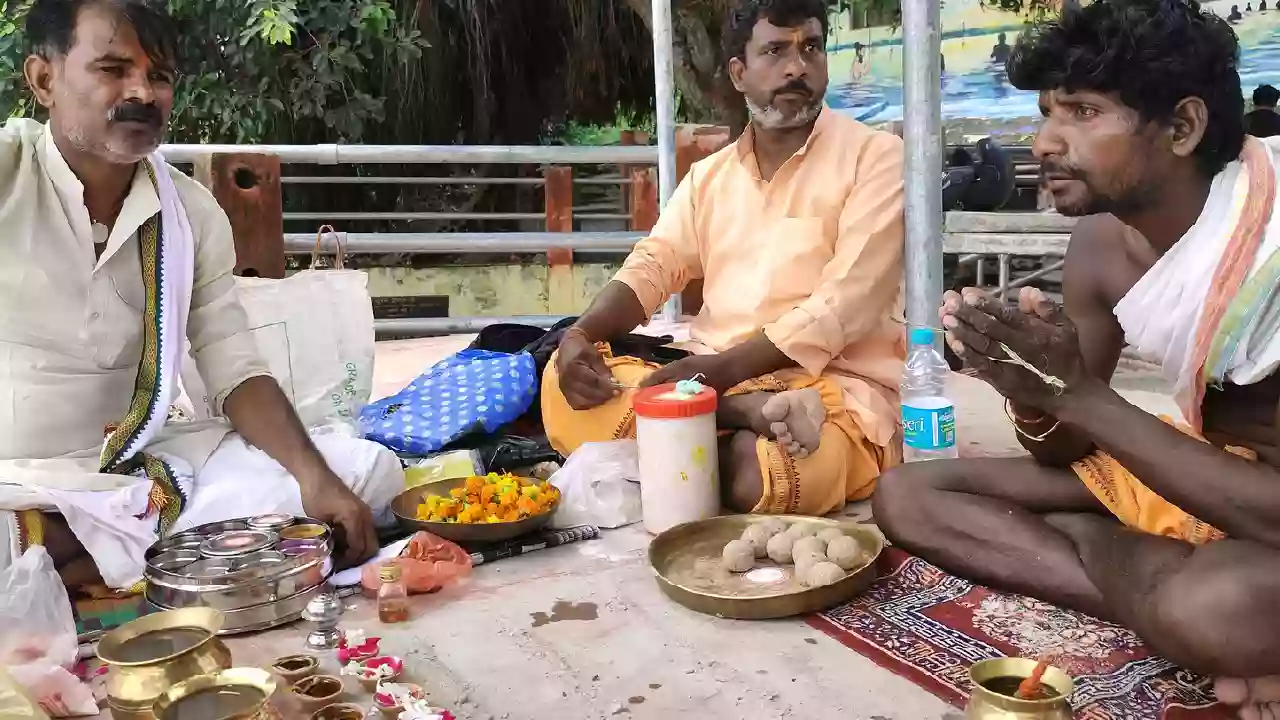Namaste,
While the paramount rule remains performing Shraddha on the Tithi corresponding to the ancestor’s departure, our rich traditions have, over centuries, imbued certain Tithis with additional layers of significance or specific focus.
Pitrupaksha as a sacred pilgrimage through time, with each Tithi marking a specific station. While our primary purpose at each station is to honour the ancestor whose journey ended on that corresponding lunar day, some stations have unique characteristics or are especially dedicated to certain types of travelers on the ancestral path. This is why, today we will strengthen our understanding on Pitrupaksha shraddha tithis.

The Foundational Principle: Matching the Death Tithi Remains Supreme
It cannot be stressed enough: The single most important reason to perform Shraddha on a particular Tithi (from Pratipada to Amavasya) during Pitrupaksha is because your ancestor departed this world on that very Tithi number.
- Cosmic Link: This practice honours the unique cosmic energy signature of their departure.
- Focused Remembrance: It directs your devotion and the merit of the rituals specifically towards that individual soul.
- Scriptural Basis: This is the core instruction found in our Dharma Shastras regarding annual Shraddha.
Any additional significance associated with a Tithi, which we will explore below, is secondary to this primary rule or applies under specific circumstances (like unknown death Tithis, certain types of deaths, or specific relationships). Do not get confused: If your father passed on Tritiya, you perform his Shraddha on Tritiya during Pitrupaksha, regardless of any other associations that day might hold.
With that crucial understanding, let us now walk through the Tithis of Ashwin Krishna Paksha:
Exploring the Specific Tithis of Ashwin Krishna Paksha

(Note: Pitrupaksha includes 15 Tithis of this Paksha. Purnima Shraddha, often done on Bhadrapada Purnima just before this Paksha begins, was discussed separately).
Pratipada Shraddha (First Tithi)
- Primary Significance: For ancestors who passed away on the Pratipada Tithi (of any month, any Paksha).
- Additional Association (Conditional): Matamaha Shraddha (Nana Shraddha): Pratipada Shraddha during Pitrupaksha is sometimes associated with honoring the maternal grandfather (Nana or Matamaha), especially if:
- The designated day for Matamaha Shraddha (which is technically Ashwin Shukla Pratipada, the day after Sarvapitri Amavasya) cannot be observed for some reason.
- Or, if the daughter’s son (who typically performs it) wishes to include his Nana during the main Pitrupaksha period, particularly if his own father is still alive (as a son primarily performs for his paternal lineage).
- However, this is more of a secondary or alternative practice; the main day for Nana Shraddha remains Ashwin Shukla Pratipada for many traditions. Confirmation via family custom or Pandit is best.
Dwitiya Shraddha (Second Tithi)
- Primary Significance: For ancestors who passed away on the Dwitiya Tithi.
- No widely recognized specific additional significance is attached to this day beyond being the designated Tithi for those who departed on Dwitiya. The focus remains on honouring them through Tarpan, Pind Daan (if applicable), and other rites.
Tritiya Shraddha (Third Tithi)
- Primary Significance: For ancestors who passed away on the Tritiya Tithi.
- Like Dwitiya, its main importance lies in being the correct day for remembering ancestors who left on the third lunar day. Performing the rituals with faith ensures their blessings.
Chaturthi Shraddha (Fourth Tithi)
- Primary Significance: For ancestors who passed away on the Chaturthi Tithi.
- Potential Auspicious Conjunction (Maha Bharani): While Chaturthi itself doesn’t have a unique universal significance, if the Bharani Nakshatra happens to coincide with Chaturthi (or sometimes Panchami) Tithi during Pitrupaksha, that day becomes exceptionally auspicious for Shraddha. This conjunction is called Maha Bharani Shraddha, and performing rites on this day is considered by some texts to be as meritorious as performing Shraddha at the sacred site of Gaya. One must check the Panchang for the specific year to see if this conjunction occurs.
Panchami Shraddha (Fifth Tithi)
- Primary Significance: For ancestors who passed away on the Panchami Tithi.
- Association with Unmarried Departed (‘Kunwara Panchami’): Panchami Shraddha is sometimes specifically associated with performing rites for family members who died unmarried. This practice is sometimes referred to as ‘Kunwara Panchami’. It ensures that these souls, who did not leave direct descendants to perform their rites, are also remembered and nourished.
- Again, check for the Maha Bharani Nakshatra possibility if it aligns with Panchami.
Shashthi Shraddha (Sixth Tithi)
- Primary Significance: For ancestors who passed away on the Shashthi Tithi.
- No widespread unique designation; the focus is purely on those whose departure Tithi was Shashthi.
Saptami Shraddha (Seventh Tithi)
- Primary Significance: For ancestors who passed away on the Saptami Tithi.
- Similar to Shashthi, its importance lies in aligning with the ancestor’s specific departure day.
Ashtami Shraddha (Eighth Tithi)
- Primary Significance: For ancestors who passed away on the Ashtami Tithi.
- Its main role is to serve as the Shraddha day for those connected to this Tithi number.
Navami Shraddha (Ninth Tithi) – Avidhava Navami / Matru Navami
- Primary Significance: For ancestors who passed away on the Navami Tithi.
- VERY Special Significance: Avidhava Navami: This day holds profound importance. It is specifically dedicated to performing Shraddha for married women (‘Suhagan’ or ‘Saubhagyavati’) who passed away before their husbands.
- Avidhava means ‘one who is not a widow’.
- The rites performed on this day aim to ensure the continued well-being, peace, and marital blessedness of these female ancestors in the afterlife.
- It is a day to particularly honour one’s deceased mother (if she passed away before the father), grandmother, great-grandmother, and other married female relatives who fit this condition. For this reason, it is also often called Matru Navami (Mother’s Ninth).
- Even if the woman’s death Tithi was different, her Shraddha might also be performed or specially emphasized on Avidhava Navami by some families, in addition to her actual Tithi Shraddha. Consult family tradition.
Dashami Shraddha (Tenth Tithi)
- Primary Significance: For ancestors who passed away on the Dashami Tithi.
- The focus returns to matching the specific departure Tithi.
Ekadashi Shraddha (Eleventh Tithi) – Indira Ekadashi
- Primary Significance: For ancestors who passed away on the Ekadashi Tithi.
- Special Significance (Indira Ekadashi): Ekadashi, being sacred to Lord Vishnu (the preserver and giver of Moksha), carries special merit. The Ekadashi falling during the Pitrupaksha (Ashwin Krishna Paksha) is known as Indira Ekadashi.
- Performing Shraddha on this day is considered highly auspicious.
- It is believed that the merit generated, especially if accompanied by fasting (as is common for Ekadashi observances dedicated to Vishnu), greatly aids the ancestors in attaining higher realms or even liberation (Moksha).
- Lord Vishnu’s grace is invoked for the ancestors’ salvation.
Dwadashi Shraddha (Twelfth Tithi) – Yati Dwadashi / Sanyasi Shraddha
- Primary Significance: For ancestors who passed away on the Dwadashi Tithi.
- Special Significance: Yati Dwadashi: This day is specifically earmarked for performing Shraddha for ancestors who were Yatis (ascetics), Sanyasis (renunciates), or hermits.
- These individuals have formally renounced worldly life and family ties.
- Performing Shraddha for them on this particular Tithi honours their chosen spiritual path and acknowledges their unique status.
Trayodashi Shraddha (Thirteenth Tithi) – Balolam Trayodashi / Magha Shraddha
- Primary Significance: For ancestors who passed away on the Trayodashi Tithi.
- Common Association (Children): Trayodashi Shraddha is often considered particularly appropriate for performing rites for children or young members of the family who passed away prematurely. It’s sometimes informally referred to as ‘Balolam Trayodashi’ (related to children).
- Auspicious Conjunction (Magha Shraddha): If the Magha Nakshatra coincides with Trayodashi Tithi during Pitrupaksha, it becomes highly auspicious, known as Magha Trayodashi Shraddha or simply Magha Shraddha. Performing Shraddha on this conjunction is believed to yield immense benefits and peace for the ancestors. Check the annual Panchang.
Chaturdashi Shraddha (Fourteenth Tithi) – Ghata Chaturdashi / Ghayal Chaturdashi / Shastrahat Chaturdashi
- EXTREMELY Specific Significance – NOT for Natural Deaths: This Tithi requires careful understanding.
- Primary Use: Chaturdashi Shraddha is exclusively reserved for performing rites for ancestors who met an unnatural, untimely, or violent death. This includes:
- Accidents (Ghata)
- Suicide (Atmahatya)
- Murder or being killed by weapons (Shastrahat / Ghayal)
- Death by poisoning, drowning, fire, animal attack, etc.
- Purpose: The rituals performed on this day are specifically aimed at pacifying the potentially troubled or restless souls (due to the traumatic nature of their passing) and helping them find peace and move towards higher realms.
- CRUCIAL CAVEAT: Shraddha for ancestors who died naturally (due to old age or illness) on a Chaturdashi Tithi should NOT be performed on this day. Their Shraddha should instead be performed on Sarvapitri Amavasya (the next day). Performing their Shraddha on Ghata Chaturdashi is considered inappropriate and inauspicious.
- Primary Use: Chaturdashi Shraddha is exclusively reserved for performing rites for ancestors who met an unnatural, untimely, or violent death. This includes:
Amavasya Shraddha (Fifteenth Tithi – New Moon) – Sarvapitri Amavasya / Mahalaya Amavasya
- Primary Significance: For ancestors who passed away on the Amavasya Tithi.
- Universal Significance (Sarvapitri): This is the most important day of the entire Pitrupaksha. It serves as a universal day for honouring ALL ancestors (Sarva Pitri).
- For those whose death Tithi is unknown or forgotten.
- For those whose Shraddha was missed on their specific Tithi during the fortnight.
- For ancestors who died naturally on Chaturdashi Tithi.
- For ancestors who died on Purnima Tithi (as an alternative or addition to Bhadrapada Purnima observance).
- As a concluding offering to the entire lineage, seeking forgiveness for any omissions and expressing collective gratitude.
- The power and scope of Mahalaya Amavasya are vast, and it truly deserves its own detailed exploration, but its position as the final and all-encompassing Tithi is vital to note here.
Pitrupaksha Shraddha Tithis: Remember the Hierarchy and Purpose

As we journeyed through these Pitrupaksha Shraddha Tithis, you see how layers of meaning have accrued. Yet, always circle back to the core principle: the death Tithi match is primary. The special significances (Avidhava Navami, Yati Dwadashi, Ghata Chaturdashi) address specific situations or categories of ancestors.
Understanding these nuances allows us to perform our Shraddha duties with greater awareness and targeted intention. It reflects the depth and compassion of our traditions, which strive to provide solace and appropriate remembrance for every soul, considering the circumstances of their life and departure.
Each day of Pitrupaksha offers a sacred opportunity. By knowing the specific relevance of each Tithi, we engage more deeply with this profound period of ancestral connection.
May this knowledge help you observe Pitrupaksha with even greater clarity and devotion.
